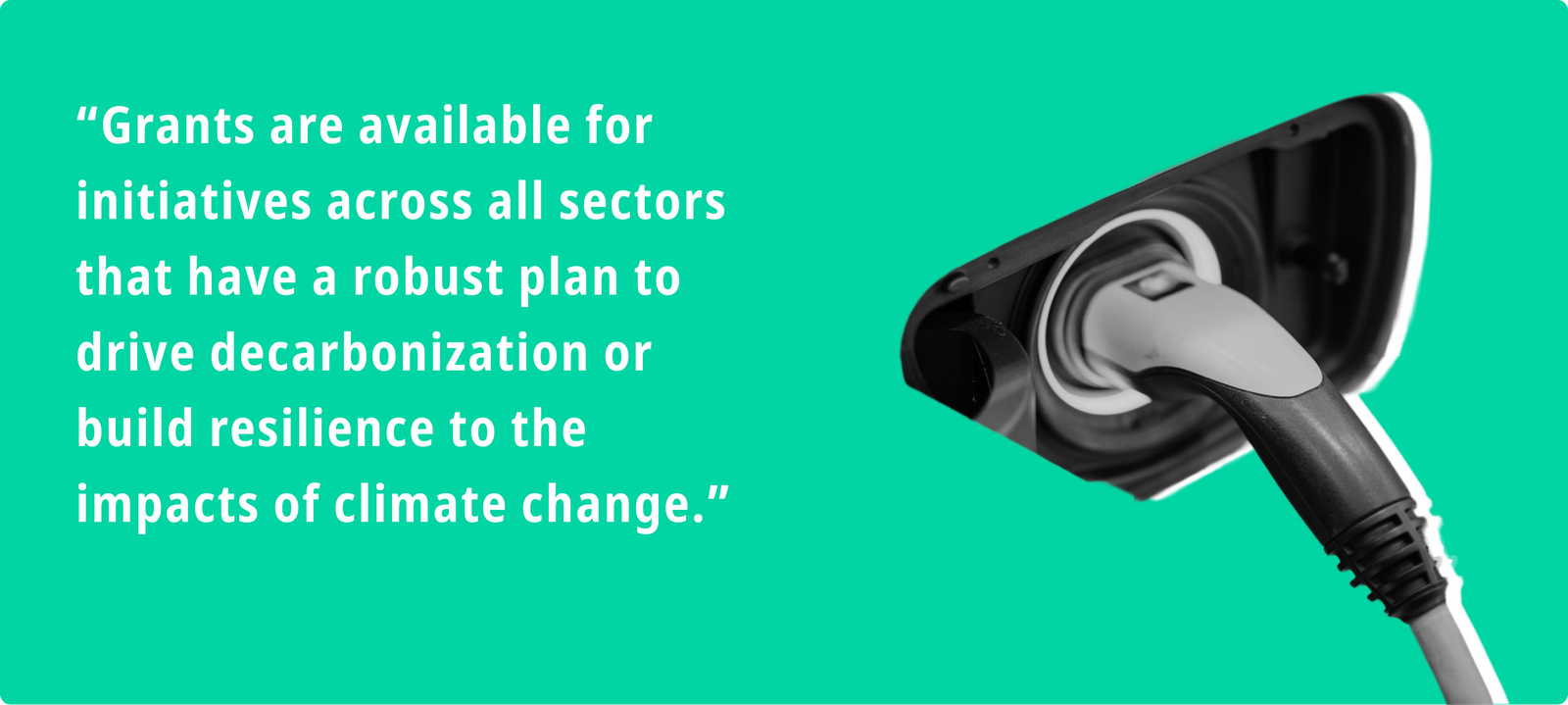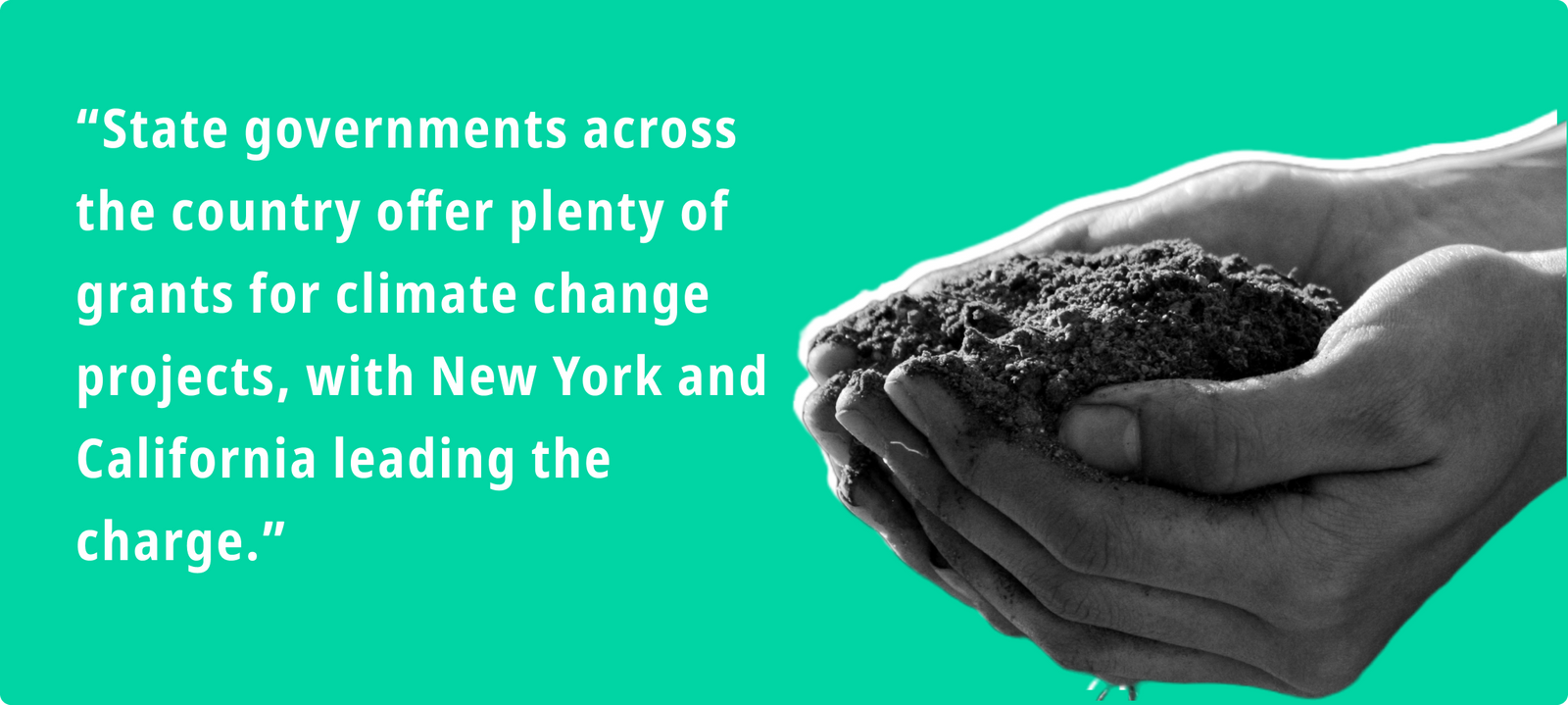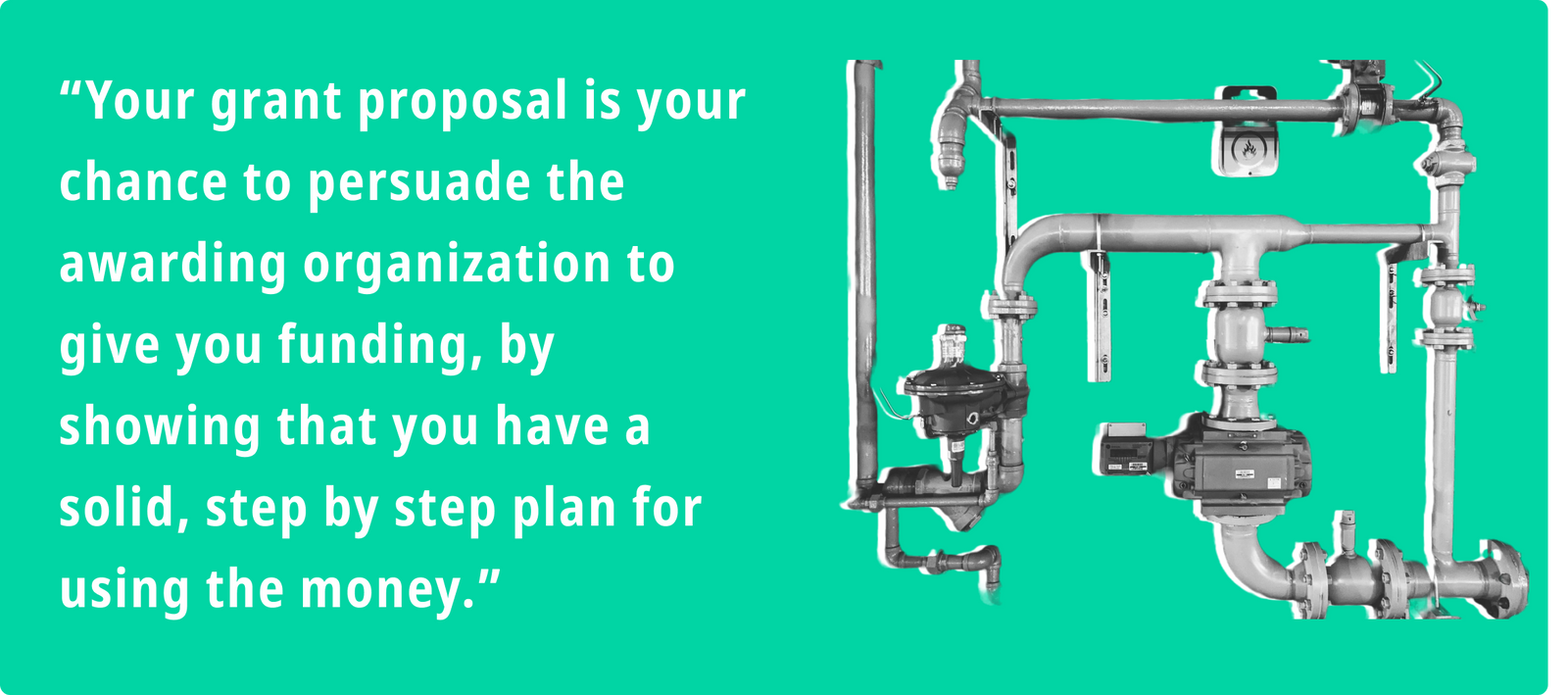All posts

Grants for Climate Change Projects
A complete guide to grants for climate entrepreneurs, big and small - how to find them, win them, and accelerate your climate business with non-dilutive capital.
How grants can power up your climate business
As the threat of environmental disaster looms, nonprofits, governmental organizations, and other stakeholders across the US are increasingly offering grant funding for businesses that are developing or deploying climate change solutions. These awards are critical to boosting the momentum of innovative companies that are tackling the climate crisis - they don’t need to be paid back, and grants are available for businesses of all sizes.
Unfortunately, finding and securing these opportunities can feel like a monumental task if you’re new to this type of funding. In this introductory guide, we’ll talk you through everything you need to know about winning grants so you can scale your climate solution faster and with less dilution.

Projects that are eligible for climate grants
Grants are available for initiatives across all sectors that have a robust plan to drive decarbonization or build resilience to the impacts of climate change, and projects’ scopes can range from a particular community to the entire country. Depending on the agency offering them, grant programs will have different focus areas, but opportunities are available for the majority of the climate ecosystem.
In most cases, grants are designed to support research and development (R&D), but some agency programs also help boost the commercialization and deployment of innovative technologies, especially where there’s evidence they will benefit marginalized communities. Sectors that have active grant programs today include:
- Renewable energy, storage, and grid modernization
- Energy efficiency
- Greener transport, including electric vehicles and public transportation
- Sustainable farming, forestry, and food technologies
- Climate adaptation projects to future-proof infrastructure and communities against the impacts of extreme weather
- Job training and upskilling programs to prepare the workforce for the clean energy economy
Securing grant funding as a climate startup or small business
There’s a common misconception that only nonprofits can access grant funding, but in reality, there’s nothing holding small businesses or startups back from applying for grant funding to fight climate change. Those that are developing innovative technology have a great chance of qualifying for funding, but any business that is contributing to emissions reductions or climate adaptation could also win grants. There are even funding opportunities out there specifically reserved for small businesses, such as the Small Business Innovation Research Program, which aims to drive innovation by funding research and development.
Startups and small business can often benefit from partnering with other organizations or even local government entities, instead of applying as the lead applicant for grant funding. Coalitions of partners, regardless of lead applicant, are often seen as more credible for climate grants, and are often more likely to receive funding.
Climate Change Grants in the US
Federal government agencies
As political momentum around climate change continues to grow, the US government is one of the biggest providers of grant funding for climate change projects, with offerings at federal, state, and local levels. Agencies ranging from the Department of Energy to the National Parks Service offer awards aimed at combating key issues in climate, from flood mitigation to carbon reduction and forest conservation. Major grant programs include the National Science Foundation's Climate and Large-Scale Dynamics program, the Department of Energy's Clean Energy Manufacturing Initiative, and the Environmental Protection Agency's Small Business Innovation Research Program.
Federal grants are typically disbursed via four mechanisms:
- Competitive grants, which are allocated based on the strength of applications.
- Formula grants, awarded to any applicant who meets the eligibility criteria.
- Continuation grants, offering previous recipients the chance to extend their funding.
- Pass-through grants, issued to a state agency, local government, or other eligible groups.
And each of these mechanisms can take one of two forms:
- Standard grants, where funding is paid out either up front or on a milestone basis, rather than as a reimbursement for costs incurred.
- Cooperative agreements, where grant funding is generally on a reimbursement basis. The organization may be required to match the grant, and the federal agency is generally more involved in the grantee’s project, rather than simply providing oversight.
City and state grant programs
State governments across the country offer plenty of grants for climate change projects, with New York and California leading the charge. The New York State Energy Research and Development Authority (NYSERDA) and the California Energy Commission are two of the largest agencies that provide grants to businesses working on climate-related issues, but similar efforts exist in Massachusetts, Oregon, Washington, New Jersey, and many other states.
Note that many states have different agencies and offices that offer grants. For example, in addition to NYSERDA, New York State’s Department of Environmental Conservation has run the Climate Smart Communities Grant Program since 2016, providing matching funds for different climate programs. It never hurts to keep poking around your state government’s websites for other — potentially less well known — climate change grant programs.
Grants are also available on a city level - for example, the Bay Area Air Quality Management District provides a variety of funding opportunities and credit enhancement products for climate startups and SMBs that operate in the region. Be sure to research whether your local government offers a climate change grant program.

Private and Public Foundations
The MacArthur Foundation and the Rockefeller Foundation, among many others, offer grants to support the research, innovation, and implementation of climate change solutions.
Because of their risk tolerance and long-term outlook, foundations can also provide catalytic funding - capital used to unlock additional private investment. This is the goal of the newly launched Giving to Amplify Earth Action (GAEA), a global partnership of philanthropic organizations headed by the World Economic Forum, which aims to bridge the $3 trillion gap needed to tackle climate change and biodiversity loss.
Nonprofits
Many nonprofit organizations, such as the Environmental Defense Fund and the Natural Resources Defense Council, provide a variety of climate grant programs for startups and SMBs to support their work in addressing the impacts of global heating.
Private companies
Some private companies - such as the Coca-Cola Company or Microsoft - have philanthropic arms which offer grants to support research and development of new climate technologies and bolster sustainability initiatives across communities in the US.
The lifecycle of a climate grant
Pre-award phase
Once a grant has been announced, eligible businesses apply with their proposals, outlining their vision for fighting climate change and why they require funding to do so. The organization or agency awarding the grants then reviews the applications and decides which company’s proposal was the most persuasive. For federal grants, this generally involves a panel of at least three people, and federal agency staff have the final say.
Award phase
The winning business will generally receive a Notice of Award, which lays out the stipulations of the grant. This is not a contract, however. Depending on the agency, contracting can take upwards of a year, as the terms of the grant - such as the final budget, reimbursement, and reporting criteria - need to be negotiated between the grantee and grantor. Bear in mind that some agencies don’t make a public notice of award pre-contract, but others might.

Post-award phase
With the funding in place, the grant recipient carries out the project it described in their grant proposal. Grantees are generally required to submit extensive reporting to ensure compliance and reduce any issues around funding disbursement.
Once the period covered by the grant ends, the grantee generally has 90 days to submit final reports about its expenses and performance under the grant, which are reviewed to verify it adhered to all of the grants' conditions. When the awarding agency confirms that everything has been fulfilled, the grant is officially closed out.
Applying for a grant for your climate change project or business – how to find grant opportunities
Grants databases
There are many grants databases that list available funding and are searchable by category, eligibility, and other criteria. Some come with a price tag, so it’s up to you whether the ability to easily find and organize potential grants is worth paying for. But there are also free options out there, such as the federal government’s own grant database, Grants.gov, which lists thousands of awards from federal agencies, or OpenGrants.io, which connects startups, nonprofits, and small businesses with funding opportunities.
Speak to your government representatives
Contact your mayor or governor’s office - they can help point you in the right direction, and might offer better and more up to date explanations of what’s available than the information you’ll find online. You should also connect with your local representative in Congress, their offices are often less busy than local elected officials. The scope of their jobs is also more closely related to supporting you.
Talk to friends and colleagues
Ask if anyone in your network has any recommendations for climate grants. Word of mouth is often one of the most underrated sources of information, and might unearth funding opportunities you wouldn’t otherwise hear about. The people around you can also provide an invaluable source of feedback as you draft your application. Online communities - including My Climate Journey, Work on Climate, and New Energy Network - can also provide insight and knowledge-sharing opportunities around grants.
Target the right opportunities
The majority of grants ask businesses to meet very stringent requirements, and won’t be flexible if you don’t meet all of their eligibility criteria exactly, so don’t waste your time applying for anything that isn’t a perfect match.
Before you start drafting your proposals, you’ll need to put in the initial legwork to find the right opportunities. Start with developing a realistic plan for what your business hopes to achieve, and compare what grant opportunities are offering against what you need.
If you don’t have a lot of experience with these types of grants, it’s worth hiring a consultant to help you identify, and even apply for, the right funding programs. This investment is generally highly worthwhile (see the section below on where to find help).
Be aware that you don't need to be the lead applicant in your proposal. Focus, as mentioned, on the outcomes your business hopes to achieve. If a grant opportunity is a good fit from an outcomes basis, but you are not eligible to receive the funds, be sure to explore partnerships or fiscal sponsorship options.
Write a convincing grant proposal
Your grant proposal is your chance to persuade the awarding organization to give you funding, by showing that you have a solid, step by step plan for using the money to solve a specific problem in a community or sector.
Your proposal should start with a cover letter that grabs the reader’s attention and briefly outlines what you need and why. Be concise and direct, though this can be more informal than the body of your proposal.

Describe the problem
Your grant proposal should contain a statement of need, which is where you’ll outline the underlying problem your business will solve. Describe the context behind the issue and pinpoint where other solutions have failed, bringing in data if appropriate. But don’t expect the reader to be familiar with complex technology - keep the jargon to a minimum. You should also establish a sense of urgency - what will happen if this project doesn’t go ahead?
Plan of action
Once you’ve established the acute need for your project, it’s time to show how your business will bridge this gap. Write about your overarching goal - the impact you envision your business having, such as bringing down emissions by X% - as well as outlining clear objectives that you’ll meet on the way to realizing this vision - such as by installing X number of solar panels. Your objectives should be SMART: Specific, Measurable, Attainable, Realistic, and Time-bound, and include a realistic timeline.
You’ll then need to demonstrate exactly how you’ll use the grant money to achieve these targets with a researched, detailed budget. This is one of the the most important parts of your proposal, and needs to account for everything you’ll need to execute the project and meet your stated targets - including salaries, equipment, supplies, and transport.
Build on the strength of your team and collaborators
As well as having a convincing plan, you’ll also need to show the grantor that your business is capable of carrying out the proposal, so make sure your vision highlights the expertise and experience of your staff. Whenever possible, you should also describe how your organization will partner with other stakeholders, such as NGOs or community members, to boost the impact of your project. Inclusive, collaborative approaches are often favored by grant programs.
As we learned from our conversation with Kay Aikin of Dynamic Grid, SBIR grants in particular present invaluable opportunities for building partnerships, and teaming up with other stakeholders could boost your chances of winning a grant. Join forces with organizations, research teams, and community groups to build your credibility and show that you’ve considered every angle of your project.
Double-check application guidelines
Every grant proposal will be judged based on different criteria, so never use the same application twice. Make sure to follow the guidelines and submission instructions carefully, and most importantly, remember to submit on time, as late or unfinished applications will be disqualified.
Need help writing your climate grant proposal?
Climate Finance Solutions
A consultancy which helps secure grants and other non-dilutive funding for climate-focused companies, providing support throughout each stage of the award process.
OpenGrants
A grant search engine and marketplace, OpenGrants can connect you with high-quality writers for hire.
Momentum
Momentum helps conceive of award-worthy projects, writes winning grant proposals, and offers project management support to lighten the administrative load inherent to the grant process.
Upwork
On the leading online marketplace for freelancers, you can hire a writer to bring your grant proposal to life.
ChatGPT
This rapidly evolving chatbot is a great helping hand for brainstorming ideas, but we don’t recommend giving it free rein to write your proposal.
GrantStation
As well as helping you identify funding opportunities, GrantStation is teeming with resources for crafting a compelling grant proposal, and also offers examples of successful proposals to learn from.
The downsides of grant funding
While grant funding may seem like a no-brainer for your startup or small business, there are a couple of drawbacks to be aware of.
For one, the research, planning, and organizing required for a grant can be incredibly arduous - you’ll often need to fill out stacks of paperwork and gather lots of supporting documents. Because grants are so competitive - only a small number of applications are successful - you might invest a lot of time only to come away empty handed, and even if you do win, you’ve still incurred a significant time cost.
Another important point to keep in mind is that grants often have strings attached. The grantor will oversee your spending, checking in regularly to make sure you’re doing things by the book, and preparing updates for them will also cut into your time. In cases where disputes occur, generally the resolution favors the grant agency, so be prepared.
Finally, if you are doing business with the government, you will certainly be audited at some point. Be sure you are prepared with accurate recordkeeping and rock solid accounting services. Ideally, when you start out on your grant journey, prepare for an audit from day one.
Once you’ve jumped through all the hoops in the application process, you might hear radio silence for a while until a decision is finally made. Even if you’re successful, the waiting game doesn’t end there, as the funds can take a long time for the actual money to be released to you. Most government grant programs are reimbursement based, and can take up to 90 days to pay out once you’ve submitted an invoice. When you’re waiting for funds you desperately need, that can feel like an eternity.
Jumpstart your climate journey
While you should keep these potential downsides in mind, don’t let them scare you off - there are so many companies who’ve won climate grants and used them to accelerate their mission of tackling climate change. And if you’re committed to helping the planet decarbonize, there’s bound to be funding opportunities out there for your business, too. We hope this guide has made the application process less daunting, because there’s no time to waste to tackle climate change, and every day counts when it comes to equipping organizations with the funding they need.
If you’ve recently won a grant for your climate solution, but want to skip the wait for your funds, we can help. Our Climate Grant Advance gives startups and small businesses the working capital they need to move faster on government grant projects - without any dilution or restrictive covenants - so they can start making an impact right now.
Special thanks to Sedale Turbovsky, Chief Executive Officer of opengrants.io, for editorial review and fact-checking.